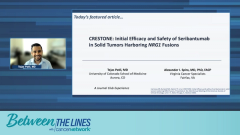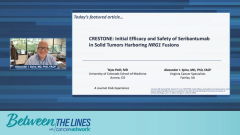
Key Takeaways From the CRESTONE Trial of Seribantumab in Solid Tumors With NRG1 Fusions
A brief review of key takeaways from the CRESTONE clinical trial of seribantumab therapy in solid tumors with NRG1 fusions.
Episodes in this series

Transcript:
Tejas Patil, MD: We’ll summarize the key takeaways. This is more of an informal discussion about where we think this drug is going and what questions we have remaining for this work. Do you want to take that away?
Alexander I. Spira, MD, PhD, FACP: We talked about the first 1. The key takeaway is that we have evidence of efficacy. In a few patients, it appears to be at least somewhat durable, with a couple of patients not having a long time since data cutoff. The real question is what’s going to be in a larger patient population. We all know that in an N [sample size] of 12, 1 or 2 patients can skew the numbers. If you have 2 more patients responding, it can go from 33% to 40% to 50%. Of course, if you selected the converse, it can go from 33% to lower. Obviously, that number is important as we get to the third comment on this page. I’ll be curious to see what the adverse effects are in a bigger population as well.
There are going to be a lot of questions about the fusion partners. I agree: I don’t think it’s going to matter too much. I’m not convinced we’re ever going to get the answers to that given the number of fusion partners. As we get to an N of 50 or 60 patients for this, we’ll identify a few more fusion partners. We’re not going to have enough of an N unless we focus on some of the preclinical work, where they can go back and see.
In terms of FDA-approval status, I’ll defer to you. I don’t know if you know more than I. I’ll always be curious to see what the FDA thinks. We’re thinking this will most likely be a tumor-agnostic approach, although a lot of the patients have lung [cancer]. Obviously that would help as we figure out a single-agent approval path rather than a larger randomized clinical study. We have a good biomarker, we know that the biomarker will correlate with the efficacy, and hopefully we can get it to a tumor-agnostic type rather than drill down on specific cancers. But we need more than lung [cancer]. Right now we’re presenting mostly patients with lung cancer.
Tejas Patil, MD: In May there was a fast-track designation by the FDA for seribantumab, largely to look at approving this treatment in a tumor-agnostic fashion. With a rare gene fusion like NRG1 and with some of the response rates that we’ve been seeing across multiple solid-tumor types, the question that comes up in my mind is, “What kind of implications will this have?” Dr Spira, we’ve already talked a little about that. We need more patients, and it will be interesting to see what happens with the FDA. I had mentioned that there was precedent before with MSI [microsatellite instability]–high tumors with pembrolizumab and NTRK gene fusions with larotrectinib and entrectinib. Do we think there will be pushback from the FDA? What are your initial thoughts and speculations?
Alexander I. Spira, MD, PhD, FACP: That’s a great question. There’s going to be a lot of excitement about this with the caveat that we need a lot more patients’ data. Right now, I’m hard-pressed to tell you that this would be fast-tracked on the basis of 12 patients. If it’s 40 or 50 [patients], we’ll be in good shape. However, I’m concerned because if almost all them are lung [cancer], then that’s not going to be enough to get a tumor-agnostic type. We’re going to want to see some of that as well. It’s fine if it’s just lung [cancer], which is obviously the predominant 1. It’s fine because we need it in lung cancer as much as we need it in other tumors, but it would be really nice to get a tumor-agnostic approval for this. My bottom line is [that the] jury is still out. We need a lot more patients and a lot more data, and we especially need [data that are] not lung cancer.
Transcript edited for clarity.
Newsletter
Stay up to date on recent advances in the multidisciplinary approach to cancer.

























































































